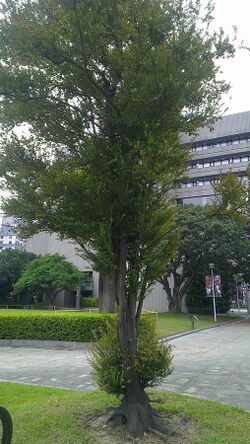Biology:Diospyros vaccinioides
| Diospyros vaccinioides | |
|---|---|

| |
| Scientific classification | |
| Kingdom: | Plantae |
| Clade: | Tracheophytes |
| Clade: | Angiosperms |
| Clade: | Eudicots |
| Clade: | Asterids |
| Order: | Ericales |
| Family: | Ebenaceae |
| Genus: | Diospyros |
| Species: | D. vaccinioides
|
| Binomial name | |
| Diospyros vaccinioides Lindl.
| |
Diospyros vaccinioides, the small persimmon, is a herbaceous plant, a member of the Ebenaceae family. This plant is mainly found in China and it is known to thrive in subtropical biomes.[1]
Description
It is a shrub with small, glossy, round leaves; it has small, white, bell-shaped flowers, and purple fruit.[2] It has veins that are arranged in a pinnate pattern. The plant has a slow growth rate and ranges in size from a shrub to a small tree, It is mainly used for ornamental value which has classified it as endangered.[3] It is an evergreen which indicates that the leaves are thick and leathery. The leaves can stay on the tree for around 2 or more years and fall at any season. The foliage remains green and is functional for more than one growing season. This plant flowers in the spring and produces fruit, a small persimmon, in the fall and winter seasons.[4] The fruit produced by this plant, small persimmons, are classified as berries.[5]
Distribution
It is an endemic species to Taiwan.[6] It is also native to China, specifically the Guangdong province, Hongkong, and Hainan. This plant is found in a subtropical biome which consists of high temperatures, low precipitation, and warm soil. Due to its affinity for these conditions, the plant has full sun exposure from a young age and a small amount of shade in all climates which means it requires a high amount of water.[3] It has no frost tolerance and high tolerance to wind.[3]
Taxonomy
It was named by John Lindley, in Exot. Fl. 2: t. 139. in 1825.[6]
References
- ↑ "Diospyros vaccinioides Lindl. | Plants of the World Online | Kew Science" (in en). http://powo.science.kew.org/taxon/urn:lsid:ipni.org:names:323155-1.
- ↑ "Diospyros Bonsai(Diospyros vaccinioides lindly) for sale | MyHomeNamture" (in zh-TW). https://www.greenflow.hk/products/diospyros-bonsai-diospyros-vaccinioides-lindly.
- ↑ 3.0 3.1 3.2 "Diospyros vaccinioides – Small Persimmon – Buy seeds at rarepalmseeds.com". https://www.rarepalmseeds.com/diospyros-vaccinioides.
- ↑ "Small persimmon (Diospyros vaccinioides) Flower, Leaf, Care, Uses" (in en). https://www.picturethisai.com/wiki/Diospyros_vaccinioides.html.
- ↑ "Small Persimmon data - Encyclopedia of Life". https://eol.org/pages/2892242/data.
- ↑ 6.0 6.1 "Diospyros vaccinioides Lindl." (in en). https://www.gbif.org/species/7295838.
External links
- Hong Kong Herbarium HK Plant Database-Diospyros vaccinioides Lindl.
Wikidata ☰ Q10959212 entry
 |




